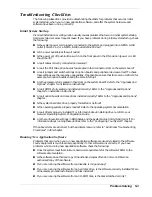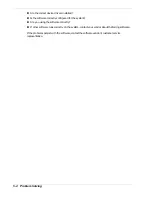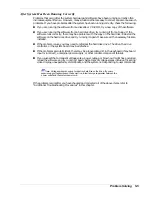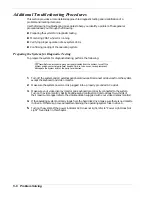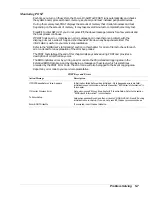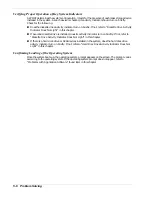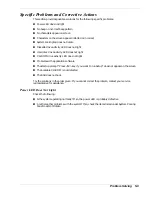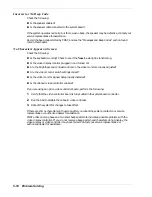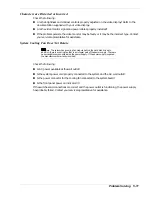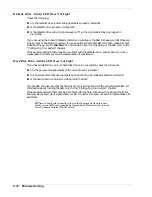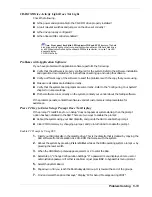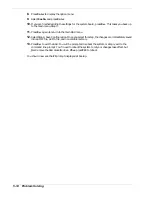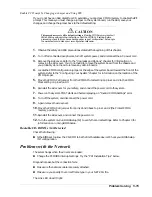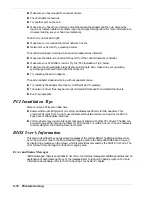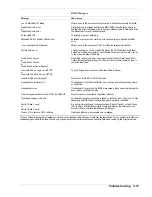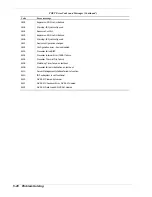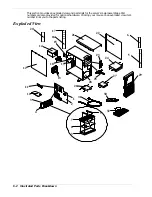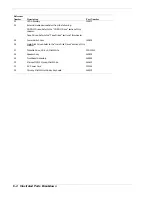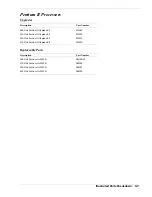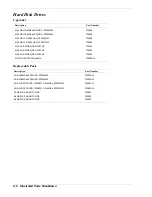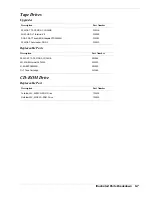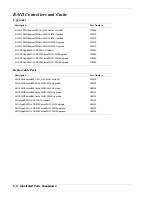
5-16
Problem Solving
n
Make sure you have loaded the network drivers.
n
Check all cable connections.
n
Try another port on the hub.
n
Make sure you have the correct type of cable between the adapter and the hub. Some hubs
require a crossover cable while others require a straight-through cable (for more information on
crossover cabling, see your hub documentation).
The Activity LED doesn’t light:
n
Make sure you’ve loaded the correct network drivers.
n
Network may be idle. Try accessing a server.
The controller stopped working when an add-in adapter was installed:
n
Make sure the cable is connected to the port from the onboard network controller.
n
Make sure your PCI BIOS is current. Try the “PCI Installation Tips” below.
n
Make sure the other adapter supports shared interrupts. Also, make sure your operating
system supports shared interrupts; OS/2 does not.
n
Try reseating the add-in adapter.
The add-in adapter stopped working without apparent cause.
n
Try reseating the adapter first; then try a different slot if necessary.
n
The network driver files may be corrupt or deleted. Delete and then reinstall the drivers.
n
Run the diagnostics.
PCI Installation Tips
Some common PCI tips are listed here.
n
Reserve interrupts (IRQs) and/or memory addresses specifically for ISA adapters. This
prevents PCI cards from trying to use the same settings ISA cards are using. Use the SSU to
keep track of ISA adapter resources.
n
Certain drivers may require interrupts that are not shared with other PCI drivers. The SSU can
be used to adjust the interrupt numbers for PCI devices. For certain drivers, it may be necessary
to alter settings so that interrupts are not shared.
BIOS User’s Information
This section describes the various screen messages of the system BIOS. The BIOS indicates errors
by writing an error code to the PS/2-standard logging area in the Extended BIOS Data Area, and
by displaying a message on the screen, which is sometimes preceded by the POST Error Code. The
error code will also be logged to the Event Logging area.
Error and Status Messages
“BIOS Messages” table is an alphabetic list of error and status messages that BIOS generates and an
explanation of each message. Many of the messages refer to the built in Setup program. For more
information about Setup, refer to the “Configuring Your System” chapter.
Содержание EXPRESS 5800 ES1400 SERIES Online
Страница 1: ...EXPRESS5800 ES1400 SERIES ONLINE SERVICE GUIDE...
Страница 8: ...Using This Guide xv...
Страница 21: ......
Страница 33: ...2 12 Setting Up the System...
Страница 60: ...Configuring Your System 3 27...
Страница 130: ...Problem Solving 5 21...
Страница 131: ......
Страница 132: ......
Страница 142: ...6 10 Illustrated Parts Breakdown...
Страница 143: ...A System Cabling n Before You Begin n Static Precautions n Standard Configuration n RAID Configuration...
Страница 149: ...System Cabling A 7 WIDE SCSI CABLE 68 pins IDE CABLE 40 pins Standard System Cable Routing...
Страница 152: ...B System Setup Utility n System Setup Utility SSU n Creating SSU Diskettes n Running the SSU n Exiting the SSU...
Страница 160: ...System Setup Utility B 9 Adding and Removing ISA Cards Window...
Страница 163: ...B 12 System Setup Utility System Resource Usage Window...


